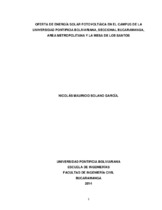Oferta de energía solar fotovoltaica en el campus de la Universidad Pontificia Bolivariana, Seccional Bucaramanga, área Metropolitana y la Mesa de los Santos
Fecha
2014Director/Asesor
Herrera Galvis, Iván Andrés
Tipo de contenido
Trabajo de grado
Citación
Metadatos
Mostrar el registro completo del ítemDocumentos PDF
Resumen
En este trabajo se determinó la oferta de energía eléctrica fotovoltaica y las ventajas económicas que representa a través de un análisis de las condiciones meteorológicas de la zona de influencia
de la estación instalada en la Universidad Pontificia Bolivariana.
Para ello, se utilizó un panel solar marca KYOCERA de potencia máxima 135 W, un controlador solar marca Morningstar, un piranómetro CC20 de Kipp & Zonen y una estación meteorológica Davis Advantage PRO, instrumentos con los que se recolectaron los datos de radiación incidente, potencia y temperaturas tanto ambiente como del panel solar, desarrolladas entre los meses de
diciembre de 2013 y enero del presente año.
Los datos fueron organización en hojas de cálculo y se graficó el comportamiento diario de las variables potencia, radiación y temperatura del panel. Se llegó a la conclusión que las menores pérdidas se producen cuando el panel se mantiene en temperaturas inferiores a los 30 C.
El análisis demostró además que los picos máximos de potencia se generan entre las 12 pm y la 1 pm alcanzando unos 70 W/h. Esto significa que con un sistema de almacenamiento continuo de la energía producida por hora se pueden generar 0.546 kW; cantidad de potencia representada en 7 televisores LCD encendidos durante una hora continua, por ejemplo.
Además, se convierte en una alternativa interesante, ya que esto significa generar 0.07 kw/h exentos de pago por un período superior a 10 años, según el período de retorno y la vida útil del
panel. In this work, the supply of photovoltaic power and the economic advantages through an analysis of weather conditions in the area of influence of the station installed at the Universidad Pontificia
Bolivariana was determined.
For this, a KYOCERA solar panel Maximum Power 135 W, a solar controller Morningstar, a pyranometer Kipp & Zonen CC20 and a weather station Davis Advantage PRO were used.
Instruments with which the incident radiation data, power, and ambient temperatures and of the solar panel, were collected between the months of December 2013 and January this year.
Data were organized at spread sheets, and the daily behavior of the variables, power, radiation and panel temperature was plotted in graphics. It is concluded that minor losses occur when the panel is
kept in temperatures below 30 º C.
The analysis also showed that the maximum peak power generated was between 12 m to 1 pm reaching about 70 W / h. This means that a system of continuous storage of the energy produced per hour can generate 0.546 kW, amount of power represented in 7 LCD television sets during one continuous hour, for example.
Besides, it becomes an interesting alternative, as this means generating 0.07 kW / h exempt from payment for a period exceeding 10 years, according to the return period and the life of the panel.
Palabra/s clave
Ingeniería Civil
Energía solar
Universidades - Universidad Pontificia Bolivariana
Temperatura
Radiación
Colecciones
- Trabajos de grado [6698]
El ítem tiene asociados los siguientes ficheros de licencia:


